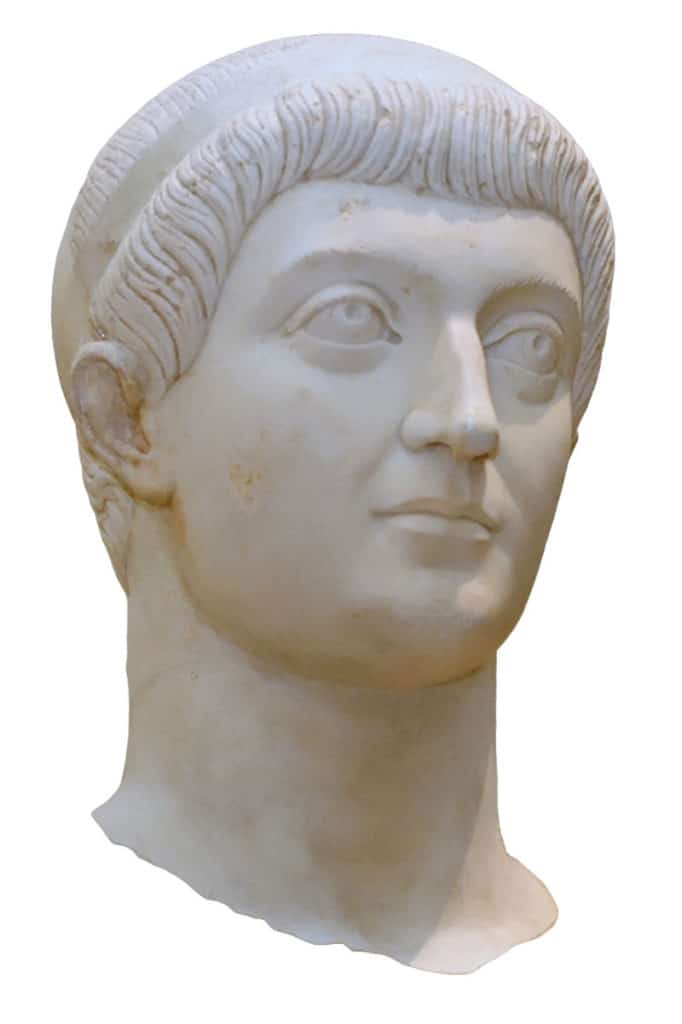Life: AD c. 320 – 350

- Name: Flavius Julius Constans
- Born in AD 320.
- Became emperor in AD 337.
- Died on in Gaul, on the way to Spanish border, January AD 350.
Constans was born in about AD 320, as the son of Constantine and Fausta. He was educated at Constantinople and was proclaimed Caesar (junior emperor) in AD 333.
In AD 337 Constantine died and Constans became joint emperor with his two brothers, Constantine II and Constantius II, after they had agreed to execute the other two heirs and nephews of Constantine, Dalmatius and Hannibalianus.
His domain was that of Italy and Africa, a small territory, when compared to those of his brothers, and one which he was not at all content with. And so after a meeting of the three Augusti in Pannonia or at Viminacium in AD 338 Constans was generously given control of the Balkan territories, including Constnatinople.
This large increase of Constans’ power, much annoyed Constantine II who in the west saw no additions to his own realm.
As the relationship with Constantine II worsened, Constans became ever more reluctant to accept his elder brother as senior Augustus.
As the situation turned more and more hostile, Constans in AD 339 handed back control of Thrace and Constantinople to Constantius II in a bribe to ensure his other brother’s support.
Finally in AD 340 things between Constantine II and Constans reached crisis point. Constans was at the Danube dealing with the suppression of the Danubian tribes. Constantine II took this opportunity to launch an attack on Italy.
Surprisingly, a vanguard urgently detached from his main army and sent to slow the invasion’s progress ambushed and killed Constantine II, leaving Constans joint ruler of the Roman world with Constantius II.
Though the joint rule of the two brothers was not an easy one. Had the ‘Nicene Creed under their father Constantine defined the Christian branch of Arianism as heresy, then Constantius II was effectively a follower of this form of Christianity, whereas Constans oppressed it in accordance to his father’s wishes.
For a while the growing divide between the two brothers created a serious threat of war, but in AD 346 they simply agreed to differ on religious matters and live in peace side by side.
In his role as a Christian emperor, much like his father Constantine, Constans took an active part in trying to promote Christianity. In turn this led him to continue the persecution of the Donatist Christians in Africa, as well as to act against the pagans and the Jews.
In AD 341/42 Constans gained notable victories against the Franks and along the Danube, before crossing to Britain where he oversaw operations along Hadrian’s Wall.
But Constans was an unpopular ruler, especially with the troops. So much so, they overthrew him. In January AD 350 a mutiny was led by Magnentius, a former slave of Constantine who had become Constans’ army chief. The mutineer proclaimed himself Augustus at Augustodunum (Autun) and Constans was forced to flee toward Spain. But one of the usurper’s agents, a man named Gaiso, caught up with Constans on the way and killed him.

Historian Franco Cavazzi dedicated hundreds of hours of his life to creating this website, roman-empire.net as a trove of educational material on this fascinating period of history. His work has been cited in a number of textbooks on the Roman Empire and mentioned on numerous publications such as the New York Times, PBS, The Guardian, and many more.
